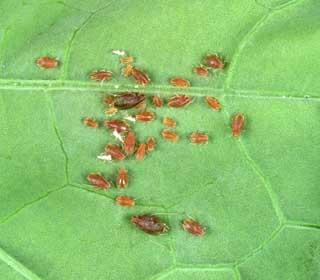Maintaining Low Levels Of Virus In The Scottish Seed Potato Crop
Published on 17 March 2010 in Sustainability and Communities , Climate, water and energy

Introduction
To maintain the competitive advantage of Scotland’s potato industry, government policy aims to maintain aphid-borne viruses in Scotland’s potato crops at low levels through crop monitoring and encouraging sustainable aphid control. These viruses are spread by aphids (greenfly) as they feed and move from plant to plant and crop to crop.
The colder northern climate has traditionally meant that these insects are less active and numerous and as a result present less of a risk when compared to other major potato producing areas in Europe. In addition to this natural advantage, different levels of aphid monitoring further improve virus control and help target insecticide control programmes.
Aphid monitoring has been most effective in combating potato leafroll virus, and its vector, the peach potato aphid Myzus persicae. In recent years, insecticide resistance has appeared in this aphid and recent research has helped us understand the implications for local seed crops.
Key Points
Fingerprinting techniques, similar to those found in forensic science, have been used to build a profile of individual peach potato aphids both locally and more widely through national and international collaboration. The research has continued for more than 15 years, a timescale that would have been difficult to achieve outwith a research organisation.
As a result a clear picture has emerged of the local peach potato aphid populations. One of the interesting facts about aphids is that a single mother can produce many generations without sex and these generations could continue for hundreds if not thousands of years. In Scotland there are many millions of individuals, but the ancestry of all these aphids can be traced back to one of 15 genetically distinct sexually-produced mothers. All of the individuals from one of these mothers are termed a clone or clonal lineage.
Thanks to our research we now have a much clearer picture of how these lineages have changed over time. The main population prior to 2001 carried little or no insecticide resistance. Any lineages with stronger resistance appeared to be at a disadvantage and while increasing locally under insecticide selection did not expand more widely.
Research Undertaken
In 2001, lineages with specific mutations (called MACE) that provided resistance to an important and widely used insecticide, (dimethyl carbamate) were detected in Scotland for the first time. They became more numerous than previous resistant lineages and caused significant problems.
After 2001, a series of new lineages arrived and expanded for one or two years and then declined, a process best described as turnover. Each new lineage carried more than one type of resistance mechanism, but this always included the MACE mutations. There was some comfort for their continued control as they all appeared to have some penalty and could not survive for long outside the relatively protected environment of a field being sprayed with the chemicals they were resistant to. Winter temperatures also play a major role in the number of peach-potato aphids that can make it through from season to season.
In 2007 the situation changed yet again with the arrival of a genotype that is simply labelled type O. It was soon clear that type O could survive over winter and in areas where insecticides had never been applied. Type O was also the first to carry only one resistance mechanism, the MACE mutations. When combined with the existing knowledge these two observations were enough to suggest that this was going to become a major problem for peach potato aphid control.
The following year this message was being delivered to users groups and insecticide manufacturers allowing them to develop policies and monitor the effectiveness of dimethyl carbamates. By 2009 the message became even stronger and advice moved to recommendation that dimethyl carbamate use should be closely monitored.
Policy Implications
While the situation is undoubtedly serious for crop protection, there is one clear Achilles heel for type O, and that is it will be controlled by many alternative insecticides. The agricultural sector and government agencies have become fully aware of the implications of this work, and are in the process of formulating policies for the future through groups such as IRAG (Insecticide Resistance Action Group). The forthcoming season will provide new interest. After one of the severest winters on record, what will the peach potato population consist of this year? Only time will tell.
Author
Dr Brian Fenton, SCRI Brian.Fenton@scri.ac.uk
Topics
Sustainability and Communities , Climate, water and energy







